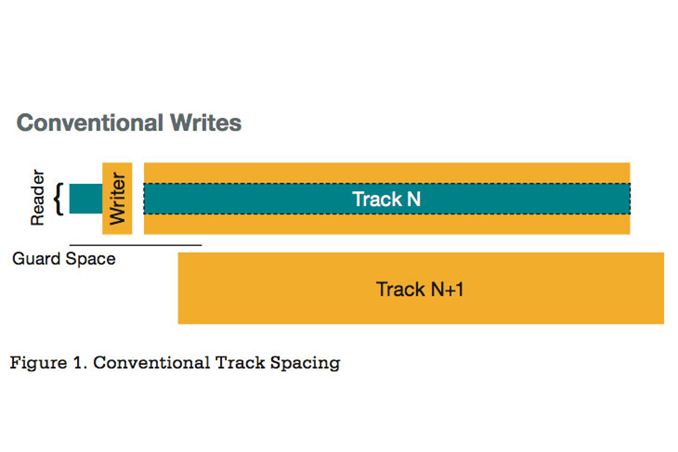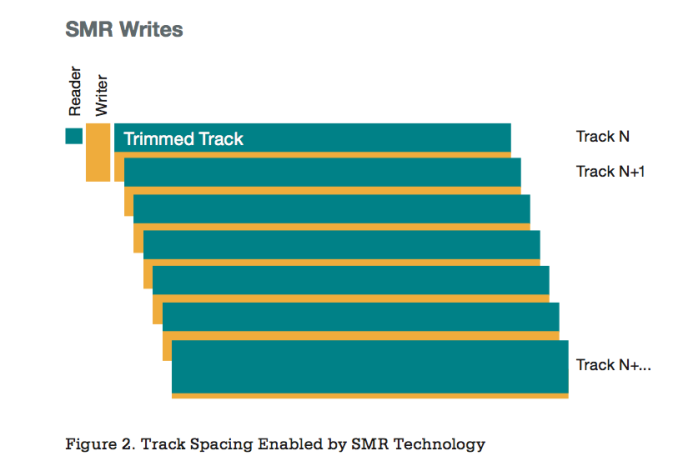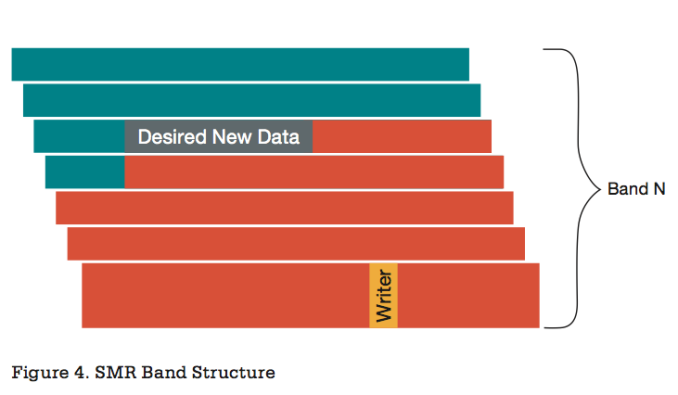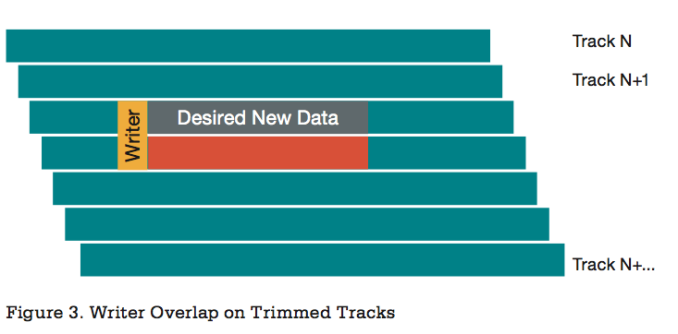Seagate to Ship 5TB HDD in 2014 using Shingled Magnetic Recording
by Anand Lal Shimpi on September 9, 2013 8:00 AM EST
It's not just planar NAND that's running into physical limits lately. According to Seagate, its latest 1TB platter 3.5" drives have shrunk read/write heads as small as they can physically go. Similarly, tracks on those platters are placed as close together as physically possible. Pushing areal density is important to increase overall capacities (no one wants to see more platters per drive), but if we're at physical limits today then it's time for some architectural changes to push capacities going forward.
Seagate's solution is something it calls Shingled Magneting Recording (SMR). The process is pretty simple. Track size is traditionally defined by the size of the write heads, as they are larger than the read heads. The track width is larger than necessary from the perspective of reading data back in order to decrease the chances of reading data from adjacent tracks. Seagate's SMR exploits this reality.
SMR shrinks the guard space between tracks and allows tracks to overlap one another, like roofing shingles. Although data is written to the entire width of the track, a smaller/trimmed portion of the track (the width of the read head) is all that the drive cares about. By allowing tracks to overlap, areal density can continue to scale without further shrinking the size of the heads.
The obvious downside of SMR is actually very NAND flash-like. When writing data sequentially to an empty platter, SMR is full of advantages. When you're writing to a series of tracks that already contains data, the SMR writing process is actually destructive. Since the writer remains full width and tracks now overlap, overwriting one track will actually harm the next track; those subsequent tracks will need to be overwritten as a result.
Seagate's SMR groups tracks into bands, with the end of each band breaking the shingled track layout. Breaking the shingled layout regularly reduces max attainable density, but it makes it so that overwriting a portion of one track doesn't force a re-write of the complete disk. At worst, overwriting some sectors will force a re-write of an entire band, not an entire platter.
Seagate claims it has already shipped 1 million SMR enabled drives (I didn't actually know any SMR drives had been shipping), but plans on using the technology to increase areal densities beginning next year. In 2014 Seagate will move from a 1TB per platter design to 1.25TB per platter thanks to SMR. The increase in platter density will allow Seagate to ship a 4 platter/5TB drive next year. Seagate is hoping to hit higher densities without any performance degradation compared to existing SMR designs. The real question is whether or not Seagate can maintain similar full drive performance compared to a non-SMR drive.













27 Comments
View All Comments
futrtrubl - Monday, September 9, 2013 - link
I would also be interested to hear what the effects of this on drive life will be considering you now have SSD like write amplification.melgross - Monday, September 9, 2013 - link
I'm not so sure it does. Rewriting a HDD doesn't weaken any of the magnetic surface the way cells are weakened in flash NAND.chaos215bar2 - Monday, September 9, 2013 - link
That's not what write amplification means.xdrol - Monday, September 9, 2013 - link
That doesn't, but rewriting means you need to write more, and more writing means more mechanical wear, at least for the head positioning mechanics.cygnus1 - Tuesday, September 10, 2013 - link
Probably not. I would imagine the head doesn't have to move at all to read or write a single "band" with this tech. It simply has to read the band prior to rewriting it with the changed data. Also, with enough NAND write buffer on the drive it may be incredibly improbable to actually hit the performance degradation imposed by this tech.madmilk - Monday, September 9, 2013 - link
Probably minimal. Hard drives wear when the head moves around a lot, but this just makes every write into a sequential write for the whole band. The head doesn't get banged around like with random I/O.glugglug - Monday, September 9, 2013 - link
Does this mean defragging the drive will have minimal effect because there is an extra mapping between logical and physical sectors?Also, I would think typical Flash wear-leveling algorithms would be unsuitable because of high random access times, so the write amplification factor once the drive is filled is probably higher than an SSD. Does the drive reorganize the data to mitigate this during idle time?
djc208 - Monday, September 9, 2013 - link
Though even with the issues in the article and the discussion, it should still dovetail in nicely with SSDs. This as a main drive may come with a performance write penalty, but with an SSD for programs/OS, and this for pictures, video, etc. where the random and small file writes would be minimized it would become even less of an issue.alexvoda - Monday, September 9, 2013 - link
HAMR seams like a much better idea than this.Both achieve higher densities but SMR sacrifices quite a lot.
The only advantage HDDs have over SSDs is the cost per data storage unit.
Adding some of the disadvantages SSDs have to HDDs will not do the technology any good as SSD prices are falling.
xdrol - Monday, September 9, 2013 - link
HAMR and SMR are not exclusive technologies, a drive could have both.